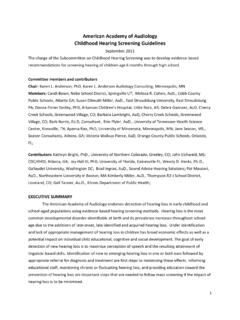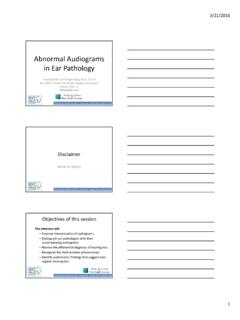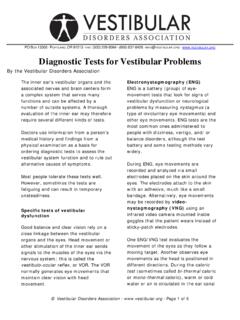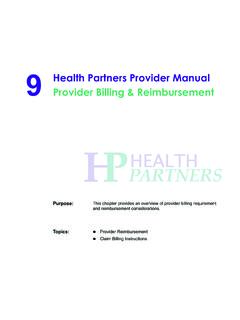Transcription of Clinical Interpretation of Distortion Product ... - KSHA
1 Clinical Interpretation of Distortion Product Otoacoustic Emissions (DPOAEs)TIFFANY JOHNSON, PHD CCC-ADEPT. OF HEARING AND SPEECH, UNIVERSITY OF KANSAS MEDICAL CENTERO toacoustic Emissions First described by David Kemp, 1978 Low level sounds that originate from the cochlea (outer hair cell activity); by- Product of normal hearing process Propagate through the middle ear and external auditory ear canal Measured in the ear canal using a sensitive microphone2 Otoacoustic Emissions Objective indirect measure of cochlear function, specifically outer hair cell (OHC) function Reflect nonlinear and sharply tuned micro-mechanics of the normal hearing process Preneural do not require 8thnerve function3 OAEs and Identification of Hearing Loss Normal cochlea behaves nonlinearly Source of nonlinearity is the OHC system Healthy, functioning OHCs required for normal hearing OAEs are byproducts of normal nonlinear function Loss of OAEs indicates damage to the OHCs4 The Clinical Link5 Loss of OAEsOHC damageInfer hearing loss is presentOAEs and Hearing Loss OAEs generally present at normal levels in ears with normal hearing, absent or present at reduced levels in ears with hearing loss Many ears with mild hearing loss have OAEs, it is hard to distinguish normal from mild hearing loss.
2 Having present OAEs (for typical Clinical protocols) generally suggests normal hearing or no more than a mild hearing loss For typical Clinical protocols the vast majority of ears with moderate to profound hearing loss have absent OAEs6 Types of OAEs Spontaneous Evoked Transient Evoked OAEs (TEOAEs) Distortion Product OAEs (DPOAEs) Stimulus Frequency OAEs (SFOAEs)7 DPOAE Stimulus and Response8 Typical Clinical stimulus conditions Stimulus levels: L1 = 65 dB SPL, L2 = 55 dB SPL Stimulus frequencies: f2/f1 = f2 often set equal to audiometric frequency. Why? Many studies suggest these conditions, particularly L1, L2 = 65, 55 dB SPL, are most accurate for identifying hearing loss ( , Stover et al., 1996; Johnson et al., 2007; 2010). Clinical Interpretation of OAEs Goal: Identify Ears with Hearing Loss How does response from normal ears differ from impaired ears?10 Next figure shows DPOAE levels for normal and impaired ears DPOAE level as a function of f2 Data from normal (left panel) and impaired (right panel) ears are shown Parameter is percentage, from 5thto 95thpercentiles Filled symbols represent the DPOAE levels at the median (50th) percentileGorga et al.
3 (1996)DPOAEs in Normal & Impaired EarsOverlap Between Normal and Impaired Responses No criterion can be selected that completely separates responses from the normal and impaired ears. Some impaired ears produce bigger responses than some normal ears And, some normal ears produce smaller responses than some impaired earsDevelopment of Template Study: Gorgaet al. (1997, E&H) Data from 1257normal and impaired ears L1/L2= 65/55 dB SPL All data collected under Clinical conditions Constructed cumulative distributionsCumulative distributions & Template ConstructionCumulative distributions & Template ConstructionBTNRH TemplateNormalImpairedUncertainUsing the templateMust judge influence of SNR 6 dB, plot DPOAE level on template, interpret SNR 6, how noisy was the response? If noise falls belowthe lower lines on the template (impaired region), plot and interpret accordingly If noise falls abovethe lower lines on the template (impaired region) responses contaminated by noise and can t be interpretedUncertain region Diagnosis is uncertainfor responses in the shaded region, even if SNR 6 dB, because responses here could be from either normal or impaired Case #1f2 frequencyDPOAE level (dB SPL)Noise level (dB SPL)SNR (dB)10008-101820003-131640002-1012 Case 1 Case 1: Results Consistent with Normal Hearing Low noise levels even for lower f2 s Large DPOAEs Positive SNRs at all f2 s Levels above 95th percentile for impaired ears Results consistent with normal hearing because few impaired ears produce such large responsesExample Case #2f2 frequencyDPOAE level (dB SPL)Noise level (dB SPL)SNR (dB)100088020000-114000000 Case 2 Case #2.
4 High Noise Levels = Uninterpretable Responses Large DPOAEs High noise levels Low SNRs Results are uninterpretable because large DPOAEs may be nothing more than noise Note that the DPOAE levels were similar to Case #1 Case #3f2 frequencyDPOAE level (dB SPL)Noise level (dB SPL)SNR (dB)1000-14-1512000-18-17-14000-18-202 Case 3 Case #3: Low SNRs & Low Noise Levels can be Interpreted DPOAEs below the lower limits of graph Noise levels also are low Low SNRs ( , DPOAE level was not measured reliably) Results are consistent with hearing loss because the reason a response was not measured was NOT due to high levels of noise, but to low level of Case #4f2 frequencyDPOAE level (dB SPL)Noise level (dB SPL)SNR (dB)10000-11112000-6-1484000-6-2014 Case 4 Case #4: DPOAEs in the region of uncertainty DPOAE levels in shaded region Noise levels well below DPOAEs Positive SNRs, meaning DPOAEs were measured reliably Results cannot be assigned to normal or impaired distributionExample Case #5f2 frequencyDPOAE level (dB SPL)Noise level (dB SPL)SNR (dB)10000-222000-5-504000-6-5-1 Case 5 Case #5: Uninterpretable DPOAEs in Region of Uncertainty DPOAEs in shaded region Noise levels = DPOAE level SNRs approximately = 0 DPOAEs therefore are not reliable Results cannot be interpreted because measured responses may be just noise, but this cannot be knownExample Case #6f2 frequencyDPOAE level (dB SPL)Noise level (dB SPL)SNR (dB)1000-14-2172000-16-2374000-16-237 Case 6 Case #6.
5 SNRs > 6 dB, Responses in Impaired Region Although SNRsall> 6 dB, theDPOAE Levelsindicate impaired OHC function, consistent with hearing loss Important to evaluate both response level and noise independently, not just the SNR Bad News - Good News Bad news: Errors in diagnoses are inevitable when OAEs are used to identify hearing loss. This is true for other tests, not just OAE tests. Good news: When auditory status is uncertain, it is more likely that we are confusing normal and mild hearing loss. It is much less likely that we are confusing normal hearing with moderate or greater ApproachesTypical Goal of OAE Testing Identify auditory status Does this ear have normal hearing or impaired hearing?39 Predicting Auditory Status:UnivariateApproach Responses interpreted by looking at information from one frequency Forexample: Is the SNR at 2kHz > 6 dB and was the DPOAE level at 2kHz consistent with normal or impaired hearing?
6 40 Predicting Auditory Status:UnivariateApproach Performance is not perfect, responses from normal and impaired ears can look the same Uncertain region on Clinical forms comes from this overlap41 Predicting Auditory Status: MultivariateApproach Measurements (DP level, noise) made at several frequencies can be used to predict auditory status at a single frequency Why do this? Normal at one frequency, likely normal at other frequencies. Impaired at one frequency, likely impaired at other Auditory Status: MultivariateApproach Need to know which frequencies help most in prediction How? Use logistic regression43 Logistic Regression Specifies which variables and associated coefficients most accurately separate a normal from an impaired ear Variables = DPOAE levels and noise values at different f2frequencies Coefficients = multipliers for the variables Generates an equationthattransformsDPOAE andnoiselevels in to LF score.
7 (!) example of LR equation LF4000= ( *DP2000+ *DP3000+ *DP4000) + ( *N3000+ *N4000+ *N6000) LF score is not a physical variable like DP level or noise but can be used to make decisions about auditory status UseLF templates score (on ordinate) is a dimensionless number derived from logistic Template46 Gorga et al., 2005 Multivariate Approach Gorga et al. (1999, 2005) First to use a multivariate analysis with DPOAEs New approach improved test accuracy Dependent on degree of hearing loss and frequency Never produced more uncertainty Improvements seen in two different studies with different subjectsJulie BangertAuDProject Does the Gorga et al. multivariate approach translate to a different clinic, different equipment, and pediatric only data set? Testedthisquestion using data from our clinic at : Subjects & Inclusion Criteria Subjects selected from KUMC Audiology Clinic pediatric data 24 subjects (n=47 ears) Ages: 6 months to years Inclusion criteria: DPOAEs Behavioral audiometric data (VRA, CPA, conventional) Normal tympanometryMethods: Behavioral & DPOAE Data Data extracted from our pediatric clinic records: Behavioral air conduction thresholds from 1- 4 kHz (interpolated at & 3 kHz) Each thresholdwasclassified asnormal ( 20 dB HL) or impaired (>20 dB HL) DPOAE and noise levels from 1-6 kHz DPOAEs classified as normal, uncertain, or impaired using BTNRH templateMethods: LF Scores DPOAE and noise levels were converted to LF scores using the Gorga et al (2005) equations.
8 Example of the LF score computation at 4kHz: LF4000= ( *DP2000+ *DP3000+ *DP4000) + ( *N3000+ *N4000+ *N6000) LF score was classified as normal, uncertain, or impaired by comparing to templateMethods: Determining AccuracyTruth (behavioral threshold) = ImpairedMethods: Determining Accuracy Whatwasconsideredan error ? If DPOAE decision differed from behavioral threshold decision N , I , orI If LFdecision differed from behavioral threshold decision N vs. I, I vs. N, uncertain vs. N or I If DPOAE wasuninterpretable due to high noise levels/poor SNRR esults: Decision Univariate DPOAEs vs. LF ScoreCorrectTest Condition1500 Hz2000 Hz3000 Hz4000 HzProportion of LevelLF Score*p=.003*p=.039 ErrorsTest Condition1500 Hz2000 Hz3000 Hz4000 HzProportion of Level LF Score*p=.003*p=.039 Results: LF OnlyErrors Test Condition1500 Hz2000 Hz3000 Hz4000 Hz3 Freq PTA4 Freq PTA5 Freq PTAP roportion of Score incorrect onlyRare for the LF score to make an error when univariate DPOAE had been correctDiscussion Increase in the number of correct decisions when using LF score vs.
9 The univariate DPOAE Few cases where the LF score caused an error and the traditional approach did not Large contribution to improved decisions with LF scores was from cases where the univariate DPOAE was uninterpretable due to high noise levels and the LF score made a correct decisionDiscussion Original formulas developed with the Biologic system generalized to the ILO system Multivariate approach does not require any more participation from the patient! It s all data analysis after the Limited data for logit function equation To compute all frequencies, you need DP emission and noise values for 750, 1000, 1500, 2000, 3000, 4000, 6000, and 8000 Hz Do not typically collectDP8000or N750 Extrapolation of DP8000 from DP6000 Did not use equations requiring N750 Small sample size (n=47 ears); but consistent with other larger studiesOverall Conclusions BTNRH templates provide an evidence-based approach to interpreting DPOAE data based on a very large data set It is importanttolookatbothDPOAE levelandnoiselevelswheninterpreting DPOAEs Multiplestudies (BTNRH andKUMC) suggest that the multivariateapproach improves DPOAE test Gorga, , Stover, L.
10 , Neely, , & Montoya, D. (1996). The use of cumulative distributions to determine critical values and levels of confidence for Clinical Distortion Product otoacoustic emission measurements. J AcoustSoc Am, 100, 968-977. Gorga, , Neely, , Ohlrich, B., Hoover, B., Redner, J., & Peters, J. (1997). From laboratory to clinic: A large scale study of Distortion Product otoacoustic emissions in ears with normal hearing and ears with hearing loss. Ear Hear, 18, 440-455. Gorga, M. P., Neely, S. T., & Dorn, P. A. (1999). Distortion Product Otoacoustic Emission Test Performance for a priori Criteria and for Multifrequency Audiometric Standards. Ear and Hearing,20(4), Gorga, M. P., Dierking, D. M., Johnson, T. A., Beauchaine, K. L., Garner, C. A., & Neely, S. T. (2005). A Validation and Potential Clinical Application of Multivariate Analyses of Distortion - Product Otoacoustic Emission Data. Ear and Hearing,26(6), 593-607. Johnson, , Neely, , Kopun, , Dierking, , Tan, H.











